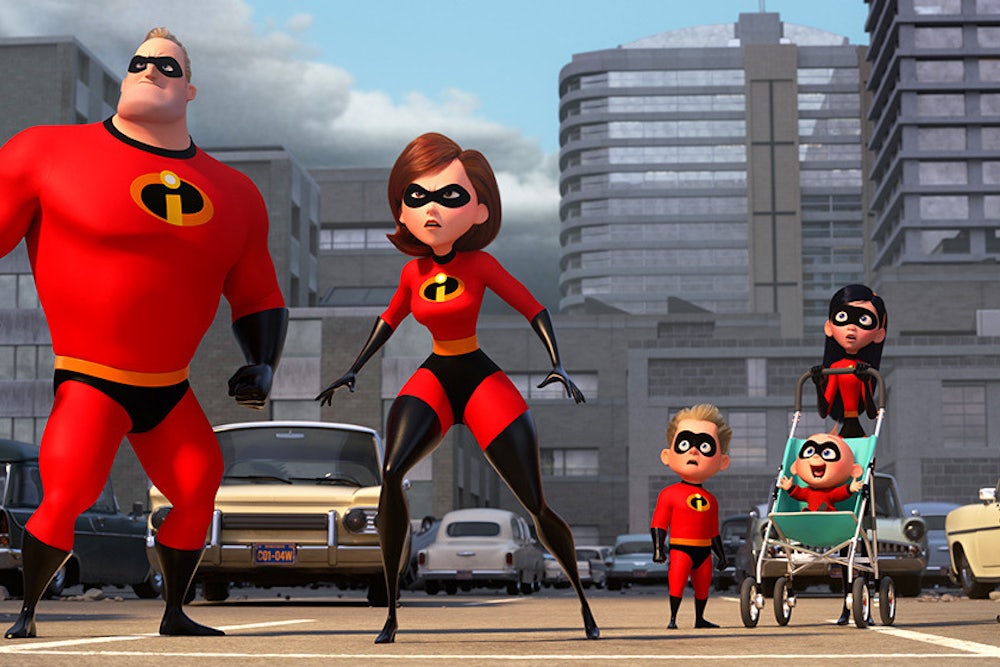The Incredibles 2 has opened to an absolute monster of a weekend across America, raking in $180 million. I saw the film way past most kids’ bedtimes, because all the other showings were sold out, but the line buzzed down the block anyway. And while children pinged around the sidewalk with excitement, I was far from the only lone adult in attendance—impressive for a movie whose predecessor came out 14 long years ago, in the year Facebook was founded.
The new movie sees the Parr family little changed by the passing of the years, though much improved by technological advances. They move more naturally and their hair looks better. The family has barely aged, however, and the plot is basically the same. Again, superheroes have been banned by the authorities on the grounds that they’re too dangerous. In the first movie, the “supers” were forced into secret identities, like a witness protection program. In the new film, superheroes are explicitly described as “illegal,” and the legality (or not) of being a superhero takes on a rhetorical flavor of immigration activism, even civil rights history.
Superheroes of all stripes are in vogue now; that part of America’s cinema-going palate is hyper-developed. But the Incredibles have their particular charms. These superheroes—Bob and Helen Parr, aka Mr. Incredible and Elastigirl, and their children Violet, Dash, and Jack-Jack—are cast in the traditional mold of comic-book champions, à la Superman. They help out little old ladies. They stop runaway trains. They live ordinary lives, they save the world.
The Parrs also cavort amid a very distinctive visual milieu. The world of The Incredibles looks, in the words of director Brad Bird, “like what we thought the future would turn out like in the 1960s.” In the sequel as in the original movie, the Parr family grapple with high-tech threats while surrounded by midcentury interior design and architecture. Reporters use old-timey cameras; televisions are sometimes black and white. In the first movie, the villain Syndrome’s lair is pretty much a copy of the Charles Deaton Sculptured House, the vast elliptical prow on Genesee Mountain. In the second, the family stays in a huge modernist mansion with more than a little of the Bond films to its design.
The Parrs are a traditional American family, so the midcentury vibe makes sense. Gender stereotyping abounds in the Incredibles franchise: In the first movie Helen vacuumed while Bob undertook secret missions, shirking his duties as a dad. In this second movie, the roles are reversed: Helen gets a chance to shine, while Bob tries and fails to keep the domestic machinery rolling. There’s something deeply conventional about the way the family operates, although the films’ good humor keeps things light. But frightening technological futures are never far away, and that’s what drags Mr. Incredible and his clan out of the house and back into the world.
Elastigirl is offered sponsorship by a mysterious and wealthy pair of siblings who run a telecommunications firm. The brother, Winston Deavor, loves superheroes and wants to help the family “rebrand.” His sister, Evelyn Deavor, is the firm’s designer. She makes the family new suits with little cameras embedded inside them, so that the public can see their heroics firsthand. She also designs a new “electric” motorbike for Elastigirl. Evelyn is a laconic Elon Musk figure, Winston a Steve Jobs. As he gives Elastigirl his recruitment speech, Winston pointedly mentions the “lobbyists” on his payroll.
At first the Deavors seem so earnest that The Incredibles 2 felt like it was drifting towards tech-billionaire apologism. But shadows fall across the movie eventually, in the form of the terrifying Screenslaver.
This villain hates superheroes, and he also seems to hate the internet. Screenslaver’s thing is hypnotizing people through their screens, getting them to commit heinous acts. He delivers monologues about the evils of superheroes and the worse evils of screens. When people get used to superheroes saving them, Screenslaver’s theory goes, it leads to them accepting the “simulation” everybody lives in. In Screenslaver’s world, both tech devices and superheroes encourage complacency.
It’s a slightly confusing argument, made all the more confusing when it turns out that there are very specific, personal motivations behind all of Screenslaver’s high-flown rhetoric. But the effect is genuinely scary. Screenslaver likes to attach goggles to people, hypnotizing them at close quarters. Those goggles are a metaphor for social conditioning, a flattening of individual perspectives into a homogenous view of the world. That screens have this effect on people seems unquestionable, these days. I just didn’t expect that metaphor to come from a kids’ movie.
Is this what children’s cinema is in 2018? The Incredibles 2 is an undeniable triumph, but it is also so keenly aware that it becomes exhausting. My notebook was full of the kind of scribbles that might accompany a documentary on contemporary America: police brutality; Tesla; Freud; the NSA. Audiences have come to expect this kind of rigor and complexity from Pixar, but the themes of The Incredibles 2 are so immediate as to make it unnerving viewing. For a kid—or at least, for the hundred or so whooping children who shared the movie theater with me on Friday night—it’s sheer fun. For an adult, it might not be the escapist dream you expected.
